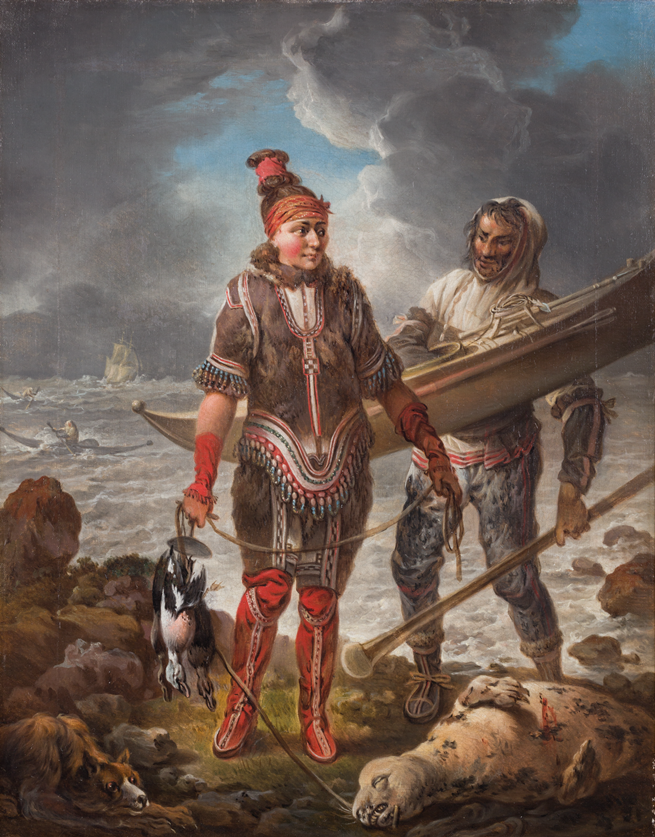Christian August Lorentzen (1749-1828) was a Danish painter and, by the beginning of 19th century, a professor at the Danish Academy of Arts. In A Greenlandic Fisher with his Bride one can recognize the influence of both the romantic movements in North Europe in the late 18th century and the Danish Golden Age (Guldalderen), between 1800-1850. In that period, Danish artists began to travel and depict foreign regions; however, C.A. Lorentzen had never been in Greenland.
This becomes most apparent in the garments, executed in high detail. The woman is dressed in a fur outfit with both pearl and leather embroidery, but if we look more closely at the kamiks we can see them folding in such a soft and plastic way that they do not look like made of tanned leather. The coat ends by the elbows, and below them she wears fringed wristbands in red cloth. She has a broad hairband on her forehead and the hair is tied up in a topknot over her head. All these elements evidently point out that C.A. Lorentzen composed a European fashion item after seeing and studying an Inuit garment. The woman’s hair colour and facial features, with her big round eyes, the light complexion and red cheeks, similarly reference Europe and the homelike, rather than the Inuit. We can even distinguish a white pearl earring on the woman’s ear, something that in 1825 definitely belonged in Copenhagen, not Greenland.
The painting shows a man and a woman standing in the middle of natural scenery. Rough see and winding grey clouds make up the background, with a stripe of blue sky right in between the man and the woman lighting the two figures up. They stand amid rocks, the woman right beside some grass. She stands there with an ulu knife and a dead bird in her hand, while a seal lies on the ground bound to a rope. She looks at the man. His gaze is in turn directed at the bird in the woman’s hand, thus drawing an imaginary line parallel to the kayak he is holding, to the paddle and also the dead seal on the ground before his feet.
The man is the active figure here; he appears to be moving, his legs slightly apart and the weight resting on one of them. With his kayak and the dead seal, he points out to the sea, from where he himself comes and where two other men on kayaks are to be seen, along with a ship in the distance. The picture captures the woman dominating in the middle of the scene like the statute of a Greek goddess. The killed animal is hers. Such look of women is common in portraits from the Danish Golden Age – as the passive, the one that is looked at.
A brown dog lies in the left corner as if about to jump; with its red eyes, it looks at the dead seal. Its forepaws are overproportioned, thus assuming a rather monstrous appearance – exaggerated and threatening. At the same time, the dog seems to be guarding. In many Golden Age paintings of the Copenhagen bourgeoisie’s homes, dogs are often depicted as an element standing for faithfulness and for a watchman of the family and the home. The dog’s reddish fur returns in both the woman’s and the man’s clothes, as well as in the seal’s blood – this creates a chromatic unity among the different figures. Perhaps nature is the couple’s home.
C.A. Lorentzen realized many landscape paintings in Norway and, in fact, the scenery surrounding the man and the woman here reminds immediately of a rocky Norwegian landscape, rather than mountains in Greenland. Although waters are rough and the clouds gather threateningly, nature is nonetheless governed by man. C.A. Lorentzen put the two people in the foreground, lit up by a stripe of blue sky and facing each other, with the dog as their guardian.
In many ways, a thread can be seen connecting C.A. Lorentzen’s painting from 1825 to Emanuel A. Petersen (1894-1948). We can recognize in Lorentzen’s painting the idea of the noble savage in harmony with nature, as well as the conception flourished in the 18th century with Jean-Jacques Rousseau that with civilization people had lost something, namely their innate relation with nature. Such a backward yearning – to find man’s lost place in wild nature, or towards the idea of some original natural condition – is present also in the works of Emanuel A. Petersen and other expedition painters, as late as more than hundred years after Lorentzen’s own day.
This article was written by Stine Lundberg Hansen. 2016.

